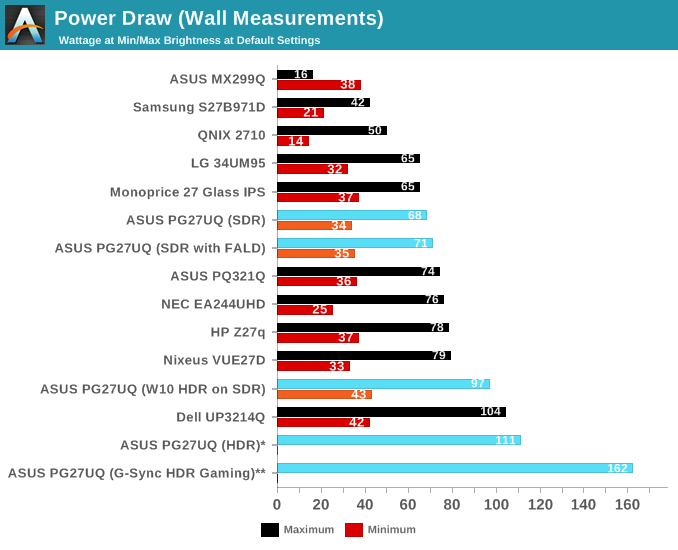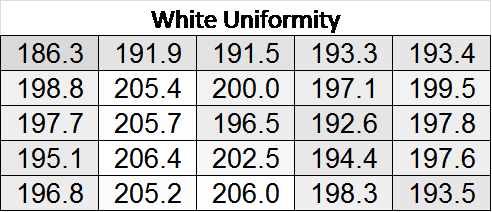The Asus ROG Swift PG27UQ G-SYNC HDR Monitor Review: Gaming With All The Bells and Whistles
by Nate Oh on October 2, 2018 10:00 AM EST- Posted in
- Monitors
- Displays
- Asus
- NVIDIA
- G-Sync
- PG27UQ
- ROG Swift PG27UQ
- G-Sync HDR
Display Uniformity and Power Usage
Especially with localized dimming, the PG27UQ's panel uniformity was solid. In the default out-of-the-box configuration (FALD enabled), the maximum local difference of white levels is around 5% of the center brightness.
Black levels were more uneven, with a general trend of brighter blacks towards the top and darker blacks towards the bottom.
Color reproduction across the panel, however, is excellent, and virtually imperceptible between different parts of the display.
Power Use
As far as power usage goes, the PG27UQ has been specified for a peak 180W with HDR on. Stand-by was specified at 0.5W, but in practice the monitor often idled for some time around 27W in the power-off mode, before finally going to sub-1W power draw. The fan is on at that time, and it's not exactly clear how this state is governed.

With G-Sync and HDR enabled, peaks of around 150W to 160W were observed during gaming, with a peak of 162W. In SDR mode, power consumption is more-or-less in line with typical monitors.















91 Comments
View All Comments
FreckledTrout - Tuesday, October 2, 2018 - link
AUO have stated it lands this fall so should be very soon. They made it sound like they will have a shipping monitor by the end of 2018 albeit who really knows but im sure its under 1 year away at this point.Can Google: "AUO Expects to Launch Mini LED Gaming Monitor in 2H18"
imaheadcase - Wednesday, October 3, 2018 - link
Don't keep hopes hope, remember this monitor in this very review was delayed 6+ monthsLolimaster - Tuesday, October 2, 2018 - link
384 zones is just CRAP, you only find that number of zones on low end cheapo TV's with FALD just o be a bit more "premium". For that price is should have 1000 AT LEAST.Seems we will need to wait for LCD with minileds to actually start seeing monitors with 5000+zones.
know of fence - Tuesday, October 2, 2018 - link
Consoles started to push that 4K / HDR nonsense and now the monopoly provides a monitor to match for the more money than sense crowd. The obscure but sensible strobing backlight / ULMB got sacrificed for the blasted buzzwords and Gsync. Is it because the panel is barely fast enough for Gsync or is it a general shift in direction, doubling down on proprietary G-stink and the ridiculously superfluous 4K native. Is it because with failing VR, high frame rates are off the table completely?Is there any mention on how 1920x1080 looks on that monitor (too bad), because the pixel density is decidedly useless and non standard. But scaled down to half it could be 81.5 ppi and this thing can actually be used to read text.
godrilla - Tuesday, October 2, 2018 - link
$1799 at micr1 fyi!godrilla - Tuesday, October 2, 2018 - link
Microcenter*Hectandan - Tuesday, October 2, 2018 - link
"the most desired and visible aspects of modern gaming monitors: ultra high resolution (4K)"No it's not. At least on Windows where UI scaling still sucks. At least on "slow" graphics card like 2080 Ti where 4K doesn't run 144fps. And 4K monitors can't do 1440p natively, so a huge deal breaker.
Zan Lynx - Wednesday, October 3, 2018 - link
If you had a graphics card that could always run 144 Hz then you would have no need for GSync.imaheadcase - Wednesday, October 3, 2018 - link
Why would you care about scaling for gaming? Besides, plenty of 3rd party apps to correct windows bullshit.Hectandan - Thursday, October 4, 2018 - link
No I don't care about scaling in games, but I do care about 144fps in games. Only possible in 4K with SLI 2080 Ti and good game SLI support. Plenty of games don't.Also plenty of 3rd party apps not correcting Windows bullshit, and I gain no extra working space if I do scale.
Simply too many downsides and too little benefit.